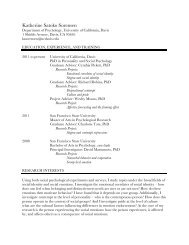SMART Board User's Guide - Psychology
SMART Board User's Guide - Psychology
SMART Board User's Guide - Psychology
You also want an ePaper? Increase the reach of your titles
YUMPU automatically turns print PDFs into web optimized ePapers that Google loves.
Two Buttons to Note: The Restore/Clear Annotations and Screen<br />
Capture Buttons<br />
A Floating Tools button that deserves special mention is the Restore/Clear Annotations<br />
button. This very useful dual-function button may in itself justify keeping the Floating Tools<br />
constantly open on your interactive whiteboard. When you write something on the board, the<br />
button is in its Clear Annotations state; as soon as you delete an annotation, the button<br />
changes to Restore Annotations.<br />
Let’s say you’ve written an important note, but your elbow grazes the board as you turn<br />
towards your audience: the annotation you just made will disappear. Just press the Restore<br />
Annotations button and your note will be restored. If you haven’t activated the Floating Tools,<br />
don’t panic. Press on the <strong>SMART</strong> <strong>Board</strong> icon, select Floating Tools, and then press the<br />
Restore Annotations button. The last cleared annotation – in this case, the one you<br />
accidentally lost – will be restored.<br />
NOTE: To access this feature for a Macintosh computer, press the <strong>SMART</strong> <strong>Board</strong> icon and<br />
select Restore Annotations.<br />
The Screen Capture button (Windows operating system only) is another valuable tool that is<br />
added to the Floating Tools whenever you write on a non-board-aware application. Use it<br />
when you want to capture your annotations plus an image of the underlying application.<br />
When you press this button, <strong>SMART</strong> Notebook software automatically launches and the<br />
current annotations plus the application background are saved as separate objects in the<br />
current Notebook file.<br />
NOTE: The screen capture feature in Macintosh computers is accessible from the drop-down<br />
<strong>SMART</strong> <strong>Board</strong> tools menu – not from the Floating Tools. When you select either Capture<br />
Screen or Capture Selection, <strong>SMART</strong> Notebook software automatically launches and the<br />
current annotations plus the application background are saved into the current Notebook file.<br />
Reconfiguring the Floating Tools<br />
You can configure the Floating Tools for your own purposes, changing the individual<br />
properties of each tool in the palette of Floating Tools.<br />
In Windows operating systems, you can customize the tool palette, adding any of a wide<br />
range of tool buttons. And, if many people use a single interactive whiteboard, you can make<br />
and save your own customized Floating Tools in a user profile (see page 23).<br />
To reconfigure the Windows Floating Tools:<br />
1 Double-press on any of the drawing tools in the Floating Tools palette.<br />
A Configure tool settings dialog box will appear.<br />
Mac<br />
Mac<br />
Win<br />
Clear Annotations<br />
Restore Annotations<br />
Win<br />
Mac<br />
OS X<br />
<strong>SMART</strong> <strong>Board</strong> User’s <strong>Guide</strong> 21
















